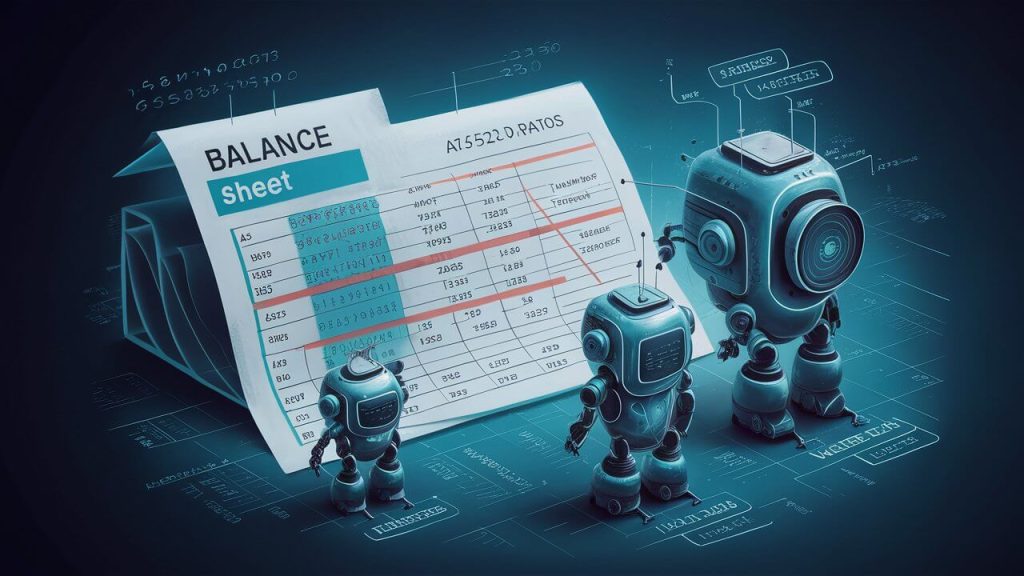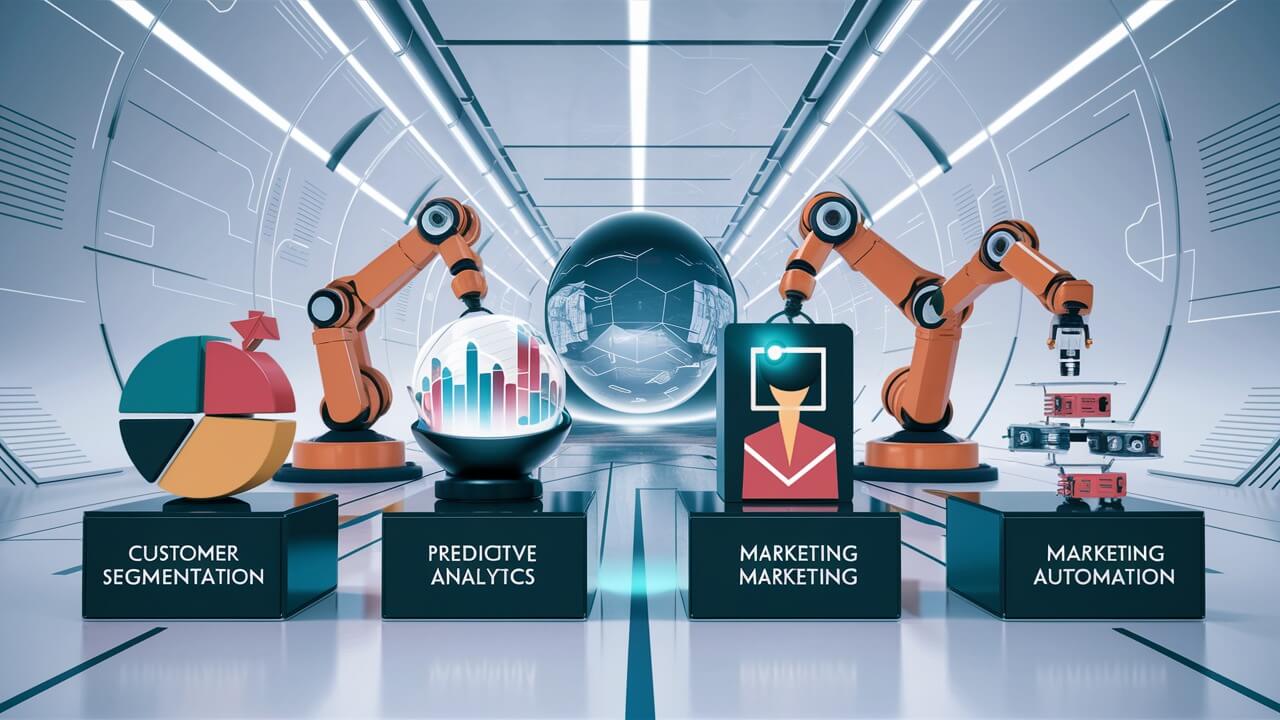Explore AI Balance Sheet Analysis and unlock transformative insights with our top 5 metrics. Streamline your financial strategy for superior outcomes.
AI Balance Sheet Analysis: Illuminating Financial Insights
In the intricate realm of finance, the balance sheet stands as a crucial document, offering a snapshot of a company’s financial health at a given moment. Traditionally, analyzing balance sheets required meticulous manual effort and expertise, often prone to human error and subjectivity. However, with the advent of Artificial Intelligence (AI), this landscape has undergone a remarkable transformation.
Unlocking Insights with AI
Welcome to the realm of AI Balance Sheet Analysis, where the marriage of advanced algorithms and financial data illuminates pathways to informed decision-making and strategic planning. In this introductory journey, we embark on a voyage to unravel the transformative potential of AI in deciphering balance sheets, demystifying complex financial metrics, and driving actionable insights for businesses of all sizes.
A Glimpse into the Future of Financial Analysis
Imagine a world where intricate financial data is not just processed but comprehensively understood, where patterns and trends hidden within balance sheets are unearthed with precision and speed unthinkable just a few years ago. This is the promise of AI Balance Sheet Analysis – a promise not just of efficiency, but of accuracy, foresight, and strategic advantage.

The Power of AI in Financial Decision-Making
As we delve deeper into the intricacies of AI-driven balance sheet analysis, we will uncover the five key metrics that serve as the cornerstone of financial evaluation:
- Liquidity Ratios: These ratios assess a company’s ability to meet short-term obligations. AI algorithms can swiftly analyze liquidity metrics, such as the current ratio and quick ratio, providing insights into a company’s liquidity position.
- Debt-to-Equity Ratios: Understanding a company’s debt structure is critical. AI algorithms can dissect debt-to-equity ratios, shedding light on the balance between borrowed funds and shareholders’ equity.
- Asset Turnover Ratios: AI can unravel the efficiency with which a company utilizes its assets to generate revenue. Whether it’s inventory turnover or asset turnover, AI-driven analysis provides clarity.
- Profitability Ratios: Profit margins, return on assets, and return on equity – these metrics define a company’s profitability. AI algorithms crunch the numbers, revealing profitability trends and areas for improvement.
- Solvency Ratios: Assessing long-term stability is essential. AI-powered solvency ratios gauge a company’s ability to meet long-term obligations, ensuring sustainable operations.
Through real-world examples and insightful analysis, we will witness firsthand the tangible impact AI can have on optimizing these metrics, enhancing financial performance, and driving sustainable growth.
Join us on this enlightening exploration of AI Balance Sheet Analysis as we navigate through the complexities of financial data, decode the language of numbers, and embrace the transformative potential of artificial intelligence in shaping the future of finance. Whether you’re a seasoned financial professional or a curious enthusiast, this journey promises to unveil new horizons and empower you with the knowledge to navigate them with confidence.
Understanding AI in Balance Sheet Analysis
AI Balance Sheet Analysis: Unleashing Data-Driven Insights
In today’s fast-paced financial landscape, making informed decisions is no longer solely reliant on intuition. Enter Artificial Intelligence (AI)—a game-changer that revolutionizes the way we analyze balance sheets, guiding investments, loans, and business strategies.
Understanding AI
At its core, AI simulates human intelligence in machines. These intelligent algorithms process vast amounts of financial data, learn from patterns, and generate insights. But how does AI specifically impact balance sheet analysis?

Applications of AI in Balance Sheet Analysis
- Data Processing Efficiency:
- Traditional balance sheet analysis involves sifting through heaps of financial data manually. AI automates this process, enabling lightning-fast data processing and analysis.
- Imagine an AI-powered assistant sorting through stacks of paperwork, leaving financial professionals with more time for strategic decision-making.
- Pattern Recognition:
- AI algorithms excel at spotting complex patterns within financial data.
- They identify trends in revenue growth, expense patterns, and asset utilization that might escape human eyes.
- Think of AI as your financial detective, uncovering hidden insights.
- Predictive Analytics:
- AI models predict future outcomes based on historical data.
- In balance sheet analysis, they forecast financial performance and identify risks.
- Imagine having a crystal ball that helps you prepare for what lies ahead.
- Risk Assessment:
- AI-powered risk assessment models evaluate factors like debt levels, liquidity, and market conditions.
- They gauge an organization’s financial health, aiding investment decisions.
- Picture an AI lifeguard scanning the financial waters for potential risks.
- Decision Support:
- AI provides data-driven insights and recommendations.
- Financial professionals can make strategic choices backed by evidence.
- Consider AI your trusted advisor, guiding you toward growth and risk mitigation.
Benefits of AI in Balance Sheet Analysis
- Accuracy:
- AI algorithms analyze data with surgical precision, minimizing errors.
- Say goodbye to manual miscalculations!
- Efficiency:
- Automation streamlines analysis, freeing up professionals’ time.
- They can focus on critical decisions rather than paperwork.
- Insights:
- AI extracts valuable nuggets from complex financial data.
- These insights empower well-informed choices.
- Scalability:
- AI scales effortlessly, handling large data volumes.
- It’s suitable for organizations of all sizes.
AI transforms balance sheet analysis. As we embrace this technology, financial analysis becomes sharper, faster, and more insightful. The future? Brighter than ever!
The Role of Key Metrics in Balance Sheet Analysis
What’s a Balance Sheet Anyway?
Okay, imagine you’re playing detective. You’ve got this mysterious document—the balance sheet. It’s like a financial report card for companies. Instead of grades, it spills the beans on a company’s money secrets. Here’s what it reveals:
- Assets: These are like the company’s treasures—things they own. Think cash, buildings, fancy gadgets, and even secret pirate maps (okay, maybe not the maps).
- Liabilities: These are the company’s debts. Imagine owing your friend lunch money—companies owe stuff too! Loans, bills, and promises to pay—they’re all here.
- Equity: This is the company’s true ownership. It’s like saying, “Hey, this part of the treasure chest belongs to us!”

Meet the Key Metrics: Our Super Tools
Now, let’s talk about key metrics. They’re like magical tools that help us understand if a company is doing well or needs a financial tune-up. Imagine you’re fixing a spaceship (because why not?).
- Current Ratio: The Quick Health Check
- Think of it as checking your spaceship’s fuel gauge. The current ratio tells us if a company has enough quick cash to pay its bills.
- High current ratio? Awesome! It means the company’s pockets are full.
- Low current ratio? Uh-oh! It’s like running out of fuel mid-space journey. Not cool!
- Quick Ratio: The Emergency Kit
- Imagine you’re exploring an alien planet. Suddenly, you need oxygen. The quick ratio is your oxygen tank.
- It looks at super-quick assets (like cash) versus short-term debts.
- A high quick ratio means the company can breathe easy.
- A low quick ratio? Well, it’s like forgetting your oxygen tank—yikes!
AI to the Rescue: Our Brainy Robot Friend
Now, here’s where the magic happens. Imagine having a robot buddy named AI. It’s like R2-D2, but with a calculator brain.
- AI crunches numbers faster than a warp-speed spaceship. It looks at balance sheets, winks at spreadsheets, and whispers secrets.
- Instead of humans spending hours calculating, AI does it in a snap! It’s like having a math genius on speed dial.
- And guess what? AI gives us super-accurate insights. It spots trends, predicts the future, and even warns us about financial black holes.
- So, when you hear about AI in balance sheet analysis, think of it as our secret weapon—a financial superhero!
Balance sheets + key metrics + AI = Financial Adventure! Whether you’re a curious teen or a seasoned space explorer (or both), remember: These tools help us decode the money universe. So go ahead, explore, and may your financial force be with you!
key metrics are essential tools in balance sheet analysis, allowing stakeholders to gain deeper insights into a company’s financial standing. With the integration of AI technology, the process of analyzing key metrics has become more efficient and effective, paving the way for smarter financial decision-making.
5 Key Metrics for Transformative Balance Sheet Analysis
AI Balance Sheet Analysis: A Simplified Guide
In the financial world, a company’s balance sheet is like its blueprint. It gives us crucial insights into the company’s health, performance, and growth potential. With the introduction of artificial intelligence (AI), this process has become even more detailed and insightful. Let’s explore five key metrics that AI enhances in balance sheet analysis, and understand their importance and the transformative results they can bring.
1. Boosting Liquidity Ratio
Liquidity Ratio Basics: Liquidity ratios tell us how well a company can cover its short-term debts with its current assets. A high liquidity ratio means the company can easily pay off its short-term debts.
How AI Helps: AI can sift through massive amounts of financial data quickly, giving more accurate and up-to-date insights into liquidity ratios. By looking at things like cash reserves, accounts receivable, and short-term investments, AI can fine-tune liquidity ratio analysis for smarter decision-making.
Real-world Example: Think of a retail company that sees a sudden drop in sales. AI can quickly spot potential cash flow problems and suggest ways to fix them, like adjusting inventory levels or negotiating better payment terms with suppliers.
2. Enhancing Debt-to-Equity Ratio
Debt-to-Equity Ratio Basics: The debt-to-equity ratio shows a company’s financial leverage by comparing its total debt to its shareholders’ equity. A lower ratio means less financial risk, as the company relies less on borrowed money.
How AI Helps: AI can analyze past financial data and market trends to fine-tune debt-to-equity ratio analysis. By spotting patterns and correlations, AI can help businesses make informed decisions about their capital structure and financing options.
Real-world Example: Imagine a tech startup deciding whether to raise funds through debt or equity financing. AI can assess the potential impact on the company’s financial health and suggest the best financing option based on its risk tolerance and growth goals.
3. Improving Asset Turnover Ratio
Asset Turnover Ratio Basics: The asset turnover ratio shows how efficiently a company generates revenue from its assets. A higher asset turnover ratio means the company is using its assets more effectively to generate sales.
How AI Helps: AI can analyze operational data and market trends to fine-tune asset turnover ratio analysis. By spotting inefficiencies in asset use and suggesting process improvements, AI can help businesses maximize their revenue potential.
Real-world Example: Think of a manufacturing company wanting to streamline its production process. AI can spot bottlenecks and inefficiencies in the production line, allowing the company to take corrective action and improve its overall efficiency and profitability.
4. Maximizing Profit Margin
Profit Margin Basics: Profit margin shows a company’s profitability by comparing its net income to its total revenue. A higher profit margin means the company is making more profit for each dollar of sales.
How AI Helps: AI can analyze cost structures and market trends to fine-tune profit margin analysis. By spotting opportunities to save costs and pricing strategies, AI can help businesses maximize their profitability while keeping prices competitive.
Real-world Example: Imagine a retail chain facing increasing competition and pressure on margins. AI can spot areas where the company can cut costs, like optimizing its supply chain or renegotiating vendor contracts, to maintain healthy profit margins without losing market share.
5. Efficient Working Capital
Working Capital Efficiency Basics: Working capital efficiency shows how well a company manages its short-term assets and liabilities. A higher working capital efficiency ratio means the company is using its resources efficiently to support its operations.
How AI Helps: AI can analyze cash flow patterns and operational data to fine-tune working capital efficiency analysis. By spotting opportunities to optimize inventory management, accounts receivable, and accounts payable, AI can help businesses improve their cash flow and liquidity.
Real-world Example: Think of a service-based business experiencing cash flow fluctuations due to late payments from clients. AI can spot overdue invoices and suggest strategies to speed up cash collection, like offering discounts for early payment or implementing stricter credit policies.
AI has revolutionized balance sheet analysis by enhancing traditional metrics with advanced algorithms and real-time data analysis capabilities. By fine-tuning liquidity ratios, debt-to-equity ratios, asset turnover ratios, profit margins, and working capital efficiency, AI enables businesses to make smarter financial decisions and achieve transformative results. As AI continues to evolve, its role in balance sheet analysis will only become more central, unlocking new opportunities for growth and innovation in the financial landscape.
Implementing AI Balance Sheet Analysis in Practice
Harnessing AI for Balance Sheet Analysis: A Simplified Guide

Integrating AI into balance sheet analysis might seem like a tall order initially. However, with a well-planned strategy, it can significantly boost your financial decision-making prowess. Here’s a simplified guide to make this integration seamless and effective:
- Evaluate Your Existing System: Before you jump into the world of AI, take a moment to review your current balance sheet analysis methods. Spot the bottlenecks, potential enhancements, and specific areas where AI could lend a helping hand.
- Define Your Goals: Be clear about what you want to achieve with AI in your balance sheet analysis. It could be enhancing precision, accelerating the analysis process, or discovering novel insights. Having well-defined goals will steer your implementation plan in the right direction.
- Pick the Suitable AI Tools: The success of your implementation heavily relies on choosing the right AI tools or platforms. Opt for solutions that are designed for financial analysis, equipped with features like predictive analytics, machine learning capabilities, and user-friendly dashboards.
- Incorporate AI into Your Workflow: After selecting your AI tools, it’s time to weave them into your balance sheet analysis workflow. Make sure they’re compatible with your existing systems and processes. Also, ensure your team is well-trained to leverage the new technology effectively.
- Begin Small, Then Expand: Start by applying AI to a specific aspect of balance sheet analysis, like optimizing liquidity ratios or analyzing profit margins. Keep a close eye on the results and make necessary adjustments before expanding its application to other metrics or departments.
- Track Performance and Adjust: Keep a regular check on how your AI-enhanced balance sheet analysis is performing. Keep track of crucial metrics, evaluate its impact on decision-making, and collect user feedback. Utilize this information to refine your AI algorithms and processes for ongoing improvement.
- Stay Abreast of AI Advancements: AI technology is ever-evolving, with new breakthroughs and tools cropping up frequently. Keep yourself updated about the latest happenings in AI for financial analysis, and be ready to tweak your strategies to stay competitive.
By adhering to these steps, you can successfully incorporate AI into your balance sheet analysis, unlocking valuable insights and fostering superior financial decision-making.
AI Balance Sheet Analysis: The Future of Financial Health Assessment
Imagine a world where businesses can assess their financial health with the help of artificial intelligence (AI). This isn’t just a dream, but a reality that’s unfolding right before our eyes. Let’s take a closer look at the exciting developments that are set to redefine AI Balance Sheet Analysis.
- Machine Learning Takes the Lead:
Machine learning, a key component of AI, is making waves in balance sheet analysis. In the near future, we’ll see these algorithms become even more sophisticated, leading to precise predictions and in-depth insights into financial data. This means AI can help businesses spot intricate patterns in their balance sheets, guiding them towards smarter financial strategies.
- The Power of Natural Language Processing (NLP):
NLP is changing the game for how AI systems understand text. When it comes to balance sheet analysis, NLP can pull out useful insights from financial reports and other text-based sources. We’re looking forward to seeing NLP become an integral part of AI tools for balance sheet analysis, helping businesses get a well-rounded view of their financial standing through both numbers and words.
- Visualizing Financial Insights:
Clear visualization is key to making complex financial data easy to understand. As AI Balance Sheet Analysis evolves, we’ll see a focus on improving visualization and interpretation tools. Businesses will be able to use interactive dashboards, dynamic charts, and tailored reports to easily spot trends and opportunities in their balance sheet data.
- Explainable AI Steps Up:
Explainable AI is all about AI systems being able to clearly explain their decisions and suggestions. This is especially important for balance sheet analysis, where trust in AI-driven insights is crucial. As businesses face increasing regulatory and ethical scrutiny, they’ll lean towards AI solutions that can provide transparent explanations for their analyses, ensuring accountability and compliance.
- Blockchain Joins the Mix:
Blockchain technology is set to bring a new level of transparency and integrity to financial data. We’re excited to see more collaboration between AI Balance Sheet Analysis and blockchain platforms in the future. By using blockchain, businesses can guarantee the security and accuracy of their financial data, creating a solid base for AI-powered analysis and decision-making.
the future of AI Balance Sheet Analysis is bright, with numerous advancements on the horizon set to revolutionize how businesses assess their financial health. It’s a thrilling journey, and we can’t wait to see where it leads.
Conclusion
To wrap it up, the world of finance is experiencing a significant shift with the introduction of artificial intelligence in balance sheet analysis. Thanks to AI, finance experts can now explore the complexities of balance sheets in more depth, discovering valuable insights that were once hidden among countless numbers.
The use of AI in balance sheet analysis paves the way for improved accuracy, efficiency, and scalability in financial decision-making. By utilizing sophisticated algorithms and machine learning, businesses can fine-tune crucial metrics like liquidity ratios, debt-to-equity ratios, asset turnover ratios, profit margins, and working capital efficiency with unparalleled accuracy.
As we step into the future of finance, the importance of AI in balance sheet analysis is set to increase. Upcoming technologies promise to boost our ability to analyze financial data further, empowering us to make well-informed decisions with confidence.
AI Balance Sheet Analysis: FAQ
Understanding AI Balance Sheet Analysis
AI balance sheet analysis is like having a super-powered magnifying glass that can examine and interpret the financial data in balance sheets. It uses advanced technologies, such as machine learning, to provide a more precise, efficient, and insightful analysis than traditional methods.
The Impact of AI on Balance Sheet Analysis
Imagine being able to automate repetitive tasks, spot patterns and trends in data, and even predict future outcomes. That’s what AI does for balance sheet analysis. It empowers financial professionals to make well-informed decisions and fine-tune key financial metrics.
Who Can Benefit from AI Balance Sheet Analysis?
From small startups to multinational corporations, AI balance sheet analysis is a game-changer. It doesn’t matter the size of your business or the industry you’re in. Harnessing the power of AI can boost your financial analysis capabilities and lead to better business results.
Challenges in Implementing AI for Balance Sheet Analysis
While AI offers many benefits, implementing it for balance sheet analysis isn’t without challenges. Data privacy, the need for specialized skills, and potential biases in algorithms are some hurdles to consider. But with careful planning and oversight, these can be managed, paving the way for AI to revolutionize financial analysis.
Getting Started with AI Balance Sheet Analysis
Ready to dive into AI balance sheet analysis? Start by exploring AI-powered financial analysis tools and platforms. And don’t forget about training. Upskilling your finance team in AI technologies is a crucial step towards successful implementation and adoption.




